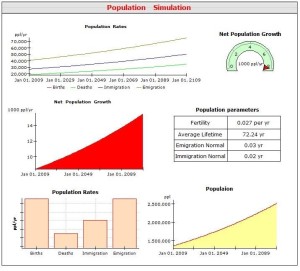The project was created within the context of the class “Analysis and Modeling”. I decided to work on a topic “Population Dynamics”. The objective of this project was to develop a demographic model of Almaty city (Kazakhstan) with the help of PowerSIM, i.e. equations, causal loop diagram and simulation output graphs, to understand the process of demographic changes in Almaty in a dynamic way and also to try to visualize and predict population dynamics of the city. This is an User Interface of Simulation Presentation.
Control Panel of Simulation:
On the control panel you can set population parameters as you want. Control Panel Diagram contains Chart Controls, Time Graph Controls and Table Controls. After that you have to run the simulation and in turn diagrams will show up. Population Model of Almaty city:
Population causal Loop Diagram:
These models can be very useful for governmental organizations or for private communities which deal with analyzing the retirement reform, healthcare reform, social impacts for some events, etc.
The causal loop diagram of the population sector shows the feedback processes that control the population level. The diagram contains 2 reinforcing and 2 balancing loops.
R1 is a reinforcing (positive) feedback loop affecting the population due to immigration. With a constant immigration factor an increase in population leads to more immigration, resulting in an increase in population.
R2 is a reinforcing feedback loop displaying the effect of the birth rate on the population. With a constant fertility, an increase in population leads to higher birth rate, resulting in an increase in population.
B1 is a balancing (negative) feedback loop showing the effect of emigration on the population. Given a constant emigration factor, an increase in population leads to greater emigration, which reduces population.
B2 is a balancing feedback loop depicting the effect of deaths on the population. Given a constant life expectancy, an increase in population leads to increase in deaths, which reduces population.




